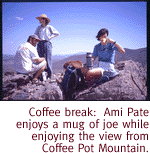
If You Want it Bad Enough, Maybe You'll See It.
By Kevin Franklin
THEY MUST HAVE been desperate for coffee," Dom Cardea
says. Our band of four humans and two dogs is riding in my Bronco,
heading east from Ajo toward Coffee Pot Mountain.
 "I bet they hadn't had coffee for months," Ami Pate
says.
"I bet they hadn't had coffee for months," Ami Pate
says.
"I'm thinking years," I say. "Look at it, it doesn't
look anything like a coffee pot. The guys who named that rock
must have been delusional for coffee. I bet they would have killed
for it."
The rhyolitic volcanic crag that makes up Coffee Pot Mountain
has two peaks, split by a shallow gap. If you have a powerful
imagination, squint at twilight when there's a lot of dust in
the air--and haven't had a cup of coffee for a long, long time--you
might think of the western peak as a spout and the eastern peak
as the top of a coffee pot. But I wouldn't.
We're here to climb Coffee Pot Mountain because it's a dramatic
peak rising up off the Sonoran Desert floor. Coffee Pot is on
the southernmost flank of the Sauceda Mountain Range, just across
the boundary from the Barry M. Goldwater Air Force Range. To the
east lies the vast Tohono O'odham Reservation. Because of the
nearby military control and reservation land, this little corner
of BLM territory remains remote and mostly untainted.
A utility road runs from south of Ajo past the mountain. The
road provides quick, albeit rough in some sections, access to
the 3,500-foot peak.
The eastern peak is a near-vertical crag that would be hazardous
for human climbing, and impossible for dog climbing. We skirt
around it on the northern side and make for the taller western
"spout" peak.
The five miles between Coffee Pot and the Batamote Mountains
to the south leave a tremendous view of open, empty desert. Large
boulders cover the steep slope of the peak and saguaros and ironwood
trees fill the space in between. Down in the plain the vegetation
is thinner, and a slight haze separates us from the Batamotes,
giving the impression of being part of a much larger landscape.
This is what a desert is all about--not swimming pools, golf courses
and sprawl, but quiet, lonely places. Humans here are like wayward
travelers, making brief ventures from their artificial ecosystems.
We scramble up to the relatively flat peak and look off into
the foothills of the Sauceda Mountains. The hard, red tuff and
ash rocks have resisted weathering, creating a maze of low-lying
peaks and crags separated by the green bands of the washes.
"That's the kind of place you could disappear into with
a backpack and not see anybody for weeks," Ami says.
 Reading the trail register we note no one has signed it in two
years. The last guy here witnessed a huge cloud of smoke and dust
rise from the nearby bombing range, like some sort of man-made
thunderhead.
Reading the trail register we note no one has signed it in two
years. The last guy here witnessed a huge cloud of smoke and dust
rise from the nearby bombing range, like some sort of man-made
thunderhead.
The irony of the restrictions imposed because of the bombing
range is that they do a remarkably good job of preserving wilderness--except,
of course, the unfortunate site they blow to hell.
We break out Ami's Thermos and enjoy a hot cup of joe. You know
we had to do it.
As we're packing up, we hear a distant rumbling. I look to the
north onto the bombing range and see a rapidly expanding detonation
cloud. It's one thing to know a place is a bombing range; it's
quite another to watch it getting bombed. So much for my delusions
about a pristine landscape.
This peak doesn't look much like a coffee pot, and a bombing
range doesn't make for much of a wilderness, but I suppose it
all depends on how much you want something. With an open-pit mine
slated for the lovely Santa Ritas south of Tucson, tacky urban
sprawl consuming the Tortolitas, and God-knows-what nonsense going
on with the Rincons and Rocking K, a man can get desperate enough
to see wilderness in a bombing range.
Getting There
Coffee Pot Mountain is 16 miles northeast of Ajo. Follow the
utility road south of the mine tailings, and it'll take you right
there.

|





